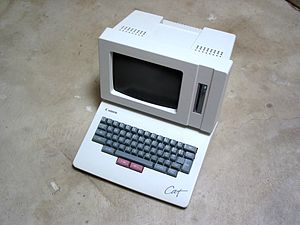Canon Cat

Canon Cat.
|
|
| Developer | Jef Raskin |
|---|---|
| Manufacturer | Canon Inc. |
| Type | task-dedicated, desktop computer |
| Release date | 1987 |
| Introductory price | US$1,495 (equivalent to $3,152 in 2016) |
| Discontinued | 1987 |
| Operating system | Forth |
| CPU | Motorola 68000 @ 5 MHz |
| Memory | 256 KB of RAM |
| Storage | 3½-inch 256 KB floppy disk drive |
| Display | 9-inch (229 mm) black-and-white monitor |
| Connectivity | Internal 300/1200 bit/s modem |
| Weight | 17 pounds (7.7 kg) |
The Canon Cat was a task-dedicated, desktop computer released by Canon Inc. in 1987 at a price of US$1495. On the surface it was not unlike the dedicated word processors popular in the late 1970s to early 1980s, but it was far more powerful and incorporated many unique ideas for data manipulation.
The Canon Cat was primarily the creation of Jef Raskin, originator of the Macintosh project at Apple. After leaving the company in 1982, he began designing a new computer closer to his original vision of an inexpensive, utilitarian "people's computer"; BYTE in 1987 described the Cat as "a spiritual heir to the Macintosh". It featured a text user interface, not making use of any mouse, icons, or graphics. All data was seen as a long "stream" of text broken into several pages. Instead of using a traditional command line interface or menu system, the Cat made use of its special keyboard, with commands being activated by holding down a "Use Front" key and pressing another key. The Cat also used special "Leap keys" which, when held down, allowed the user to incrementally search for strings of characters.
The machine's hardware consisted of a 9-inch (229 mm) black-and-white monitor, a single 3½-inch 256 KB floppy disk drive and an IBM Selectric–compatible keyboard. It used a Motorola 68000 CPU (like the Macintosh, Lisa, Atari ST and Amiga) running at 5 MHz, had 256 KB of RAM, and an internal 300/1200 bit/s modem. Setup and user preference data was stored in 8 KB of non-volatile (battery backed-up) RAM. The Cat's array of I/O interfaces encompassed one Centronics parallel port, one RS-232C serial port (DB-25), and two RJ11 telephone jacks for the modem loop. The total weight of the system was 17 pounds (7.7 kg).
...
Wikipedia
